LG Signature OLED65G7V Review
LG Signature OLED65G7V Review
The Signature model, for those with expensive tastes
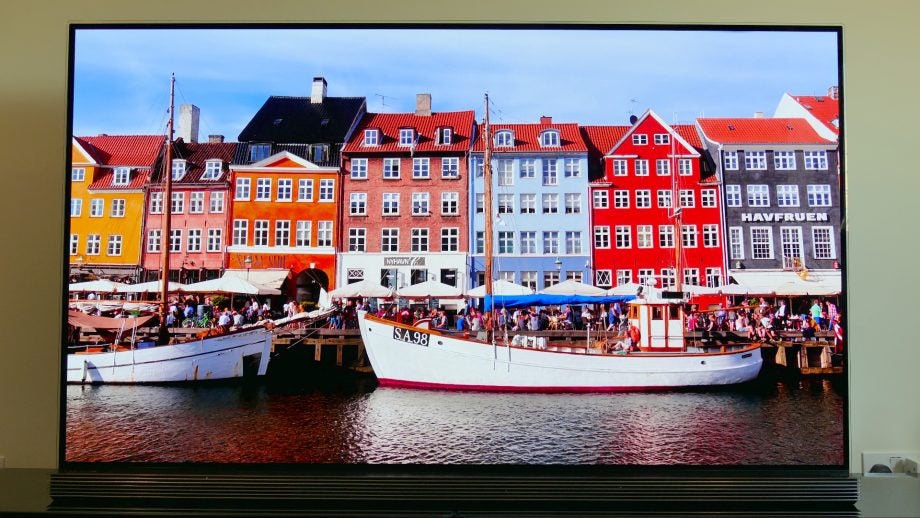
Verdict
Pros
- Stunning HDR and SDR performance
- Strong audio performance
- Lovely design
- Sound base can be folded for wall mounting
- Wide HDR compatibility
Cons
- That price tag!
- LCD TVs are brighter
Key Specifications
- Review Price: £6999.00
- 4K resolution
- 65-inch OLED panel
- HDR formats: HDR10, Dolby Vision, HLG, Technicolor
- 4.2 channel, 80W sound system
- 4 x HDMI
What is the LG OLED65G7V?
LG doesn’t hand out its ‘Signature’ badge very often. That’s because it’s reserved for VIPs: the best tech the company can muster. Last year, only the LG G6 OLED TV achieved Signature status.
Now we have its successor, the LG G7 (full name, LG OLED65G7V). And while it’s no longer the only TV to get a Signature badge this year – the wallpaper-thin LG W7 OLED shares the honour – the G7 boasts a much-improved picture performance.
Let’s be up-front about this – this is the luxury option. This is LG showing off and making a statement, and so it comes with an proportionately large price tag.
If you want this picture quality, but you don’t want the price, consider other 2017 LG OLED TVs, which offer more humble aesthetics. The LG B7 and LG C7, for instance, retail for £4499 at 65 inches.
So why might you want to pay an extra £2500 for the LG G7? It boils down to a really fancy design with an integrated and foldable sound base. That won’t be enough to justify it for most people, but buyers who want the absolute pinnacle of LG design won’t be disappointed.
Related: Best TV
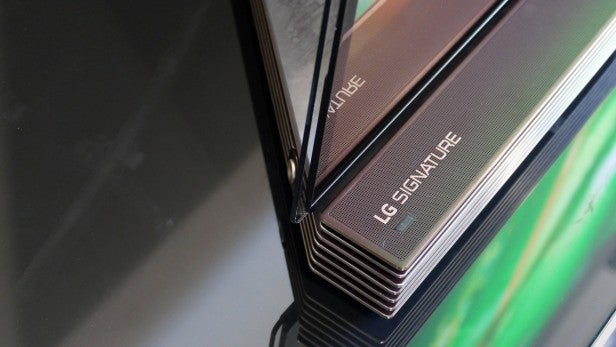
LG OLED65G7V – DESIGN
The LG OLED65G7V is easily one of the most beautiful TVs I’ve ever reviewed.
That’s quite an achievement for a recycled design – I say that because at a glance the G7 OLED looks identical to the G6, and it appears the only thing that has changed is the panel technology. That’s no bad thing, because the G6’s design was so nice that I welcome the chance to see it again.
The most striking thing here is the ‘Picture-on-Glass’ concept, which is exactly what it sounds like: a super-thin OLED panel mounted on a sheet of glass. I took the various cards out of my wallet and found the TV is roughly the thickness of seven cards. That’s pretty amazing.
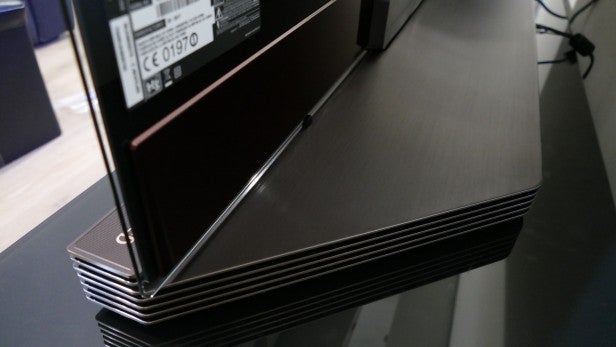
There is a thicker protrusion towards the bottom, but here it’s a lot less pronounced than on LG’s other OLED TVs. That’s because most of the electronics are housed in the chunky speaker base stand.
There you’ll find all the connections (four HDMI, three USB) along with a 4.2 channel, 80W sound system. If you want to keep the ultra-slim design uninterrupted, and wall-mount it, the whole assembly folds back on a hinge and tucks behind the screen.
If you think that’s over the top but you still want the perks of picture-on-glass, the LG E7 sports a similar design, minus the folding sound base, for less. Check out our LG OLED65E7V review for more.

LG OLED65G7V – Features
LG tells me the design and audio elements are the only things that differentiate its 2017 OLED models. They’re all equipped with same panel, the same chip, processing and filters. That means you get the same picture whether you get the more affordable B7 and C7 models or go the whole hog and buy a W7.
So, this is what you get if you buy an 2017 LG OLED TV. First off, there’s a 10-bit OLED panel with a 4K/Ultra HD resolution (3840 × 2160 pixels). It’s flat, because LG reckons there is no longer any demand for curved screens. I’m sure Samsung would have something to say about that. LG also feels there’s no need to offer 3D anymore, so that’s gone too.
What LG does support is HDR. The 2017 OLED models are compatible with every single format of high dynamic range that we know about: the common HDR10, the metadata-heavy Dolby Vision, the broadcast-friendly Hybrid Log-Gamma (HLG), and even Technicolor’s version that nobody knows anything about yet. No other manufacturer has gone this far when it comes to HDR futureproofing.
Related: Everything you need to know about HDR
It’s just as well, because this year’s OLED panel is more equipped to handle the demands of HDR, because it’s brighter. LG claims it’s about 20-30% brighter and close to 1000 nits. In practice, we’re looking at about 750 nits if you don’t use the exaggerated HDR Vivid mode – still a clear step up from last year and comfortably ticks all the boxes required for UHD Premium certification.
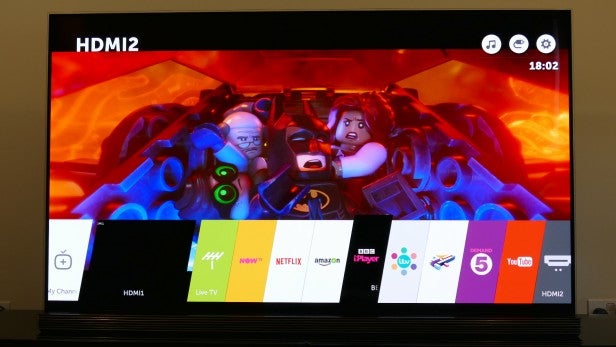
On the software side, the G7 runs on version 3.5 of LG’s excellent webOS interface. LG was the first to come up with a truly modern smart TV experience, and webOS remains the best on the market. There’s a handy launcher bar, which lets you look at your apps without making you quit what you’re currently watching. There’s a multi-tasking feature, which lets you jump between apps and inputs as easily as you might change TV channels. There’s a mouse-like cursor on the screen, controlled by a motion-sensitive remote.
Version 3.5 of webOS doesn’t rock the boat, but it does have some nice additions. You can now map your favourite apps to numbers on the remote – Netflix on speed dial, essentially. It’s also now compatible with 360-degree video clips. App support is generous and offers all the essentials: Netflix, Amazon Video, NOW TV, YouTube, BBC iPlayer, ITV Hub, All 4 and Demand 5.
LG’s Magic Remote makes a welcome return. This is one of the most user-friendly TV remotes out there. It has a full number keypad and a scroll wheel, on top of the motion-sensors I’ve mentioned already. There’s also a standard directional pad for those who don’t like to wave their arms. I also like the dedicated Netflix and Amazon Video buttons. It’s a great remote, although LG has also followed the trend and supplied a smaller remote with a stripped out button layout. I barely used that one.
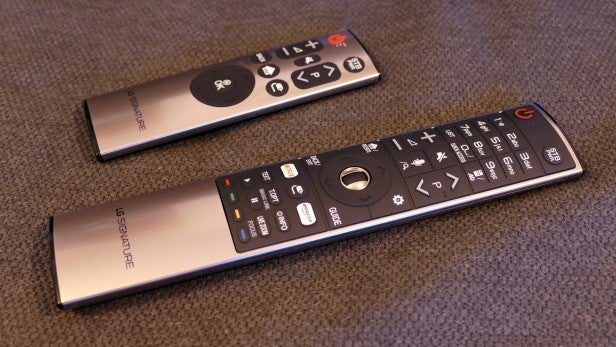
LG OLED65G7V – Video performance
As the LG G7 packs the same video tech as its siblings, I’m not surprised to see the same excellent picture performance I saw on the other sets. What you get here is clarity and dynamism, although not the final word in subtlety.
LG has been pushing OLED far longer than anyone else – and it even supplies OLED panels to other manufacturers – so it’s safe to say the company knows what it’s doing.
These days, strong contrast and lighting precision is to be expected of OLED. The way the pixels turn themselves on and off individually means there’s zero chance of light bleeding from one area into another – even if you have very bright areas right next to very dark areas. Whatever you throw at this TV, it will display without any hint of light pollution.
That’s never been a problem with OLED, but brightness has always been an issue. It’s not just a matter of peak brightness, but rather the range of luminance the TV can operate in. As this is a brighter panel, LG has more room to manoeuvre, and the effect is a noticeable improvement on last year’s OLEDs.
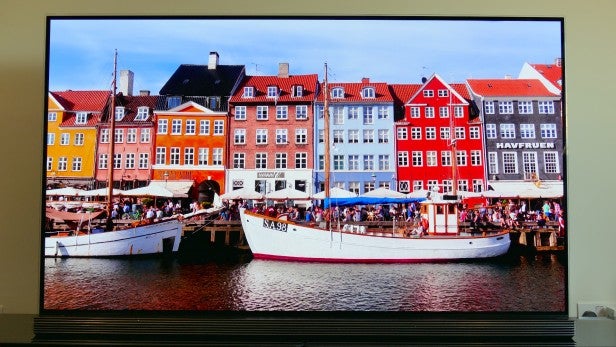
A brighter panel gets you stronger visual impact and greater contrast, which is crucial for delivering the punch of an HDR picture. Previous OLEDs struggled in this department but now I feel confident in saying OLEDs can comfortably do justice to HDR. But more important than outright punch is the increase in more steps or gradations in the extremes, which leads to more detail. You get less clipping in the highlights and the shadows are less hollow, and the result is a more natural, three-dimensional picture.
Colour handling has improved, too. No longer is there that slight reddish-purple tone you could see on LG’s 2016 models (in brighter settings). What you get is more neutral, not to mention more subtle in shading, while still delivering an SDR or HDR picture that pops.
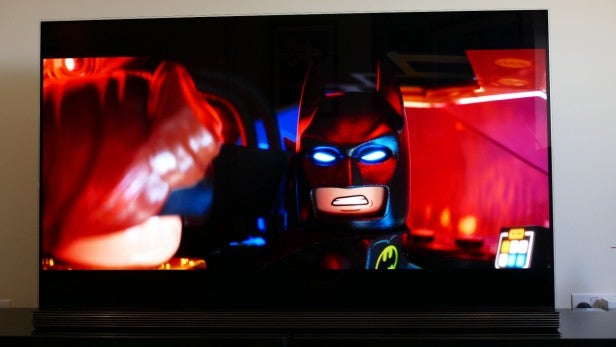
Against the competition? I feel the only significant weakness here is the colour, which isn’t nearly as natural as the Panasonic TX-65EZ952B, particularly where skin tones are concerned.
Then there’s the Sony KD-65A1, which offers more stable motion and more subtle fine detail, especially in upscaled HD/SD sources. It’s not a huge difference, though.
For brightness fans, premium LCD TVs such as the Samsung QE65Q9F offer a far brighter picture and greater colour volume – meaning greater HDR impact in bright rooms. But that’s balanced out by lighting issues visible in dark areas and in dim conditions.
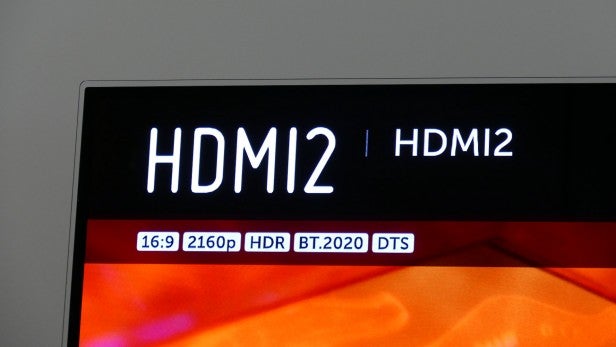
There’s good news for gamers, because LG beats everyone when it comes to latency. I recorded an input lag of 21ms on average, which is better than the 25ms on the Panasonic EZ952 and about 40ms on the Sony A1.
I’ll finish this section with a few setup tips to make the most of the TV. First, I’d recommend using a tweaked version of the Cinema preset, which looks the most natural. Turn off the energy saving mode, because otherwise that overrides a bunch of your settings. The Cinema preset is a little dark by default, so bump up the brightness up a little. Don’t go up more than a couple of points, or you’ll risk bringing in picture noise. You can turn on noise reduction, but I’d recommend against doing that, because that would leave you with a softened picture. Lastly, activate the User setting on the ‘Trumotion’ motion processing, with de-blur and de-judder set to no more than 2. You can turn motion processing off entirely, but then you’ll notice a little instability.
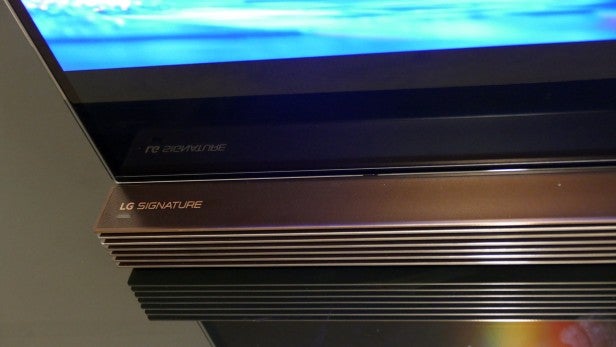
LG OLED65G7V – Audio performance
On the audio front, I’m pleased to report the OLED65G7V does very well. I’d hope so for a £7000 TV with a massive sound base, and I’m not disappointed. That being said, I’m not so sure about LG’s claims of Dolby Atmos sound.
For starters, the sound base isn’t like proper Atmos sound systems, which typically bounce effects off your ceiling to simulate the sensation of sound from above. True Dolby Atmos sound should leave you in bubble of sound with super-precise sound effects placement, and that just isn’t happening here.
Then there’s the matter of sources. The TV decodes Dolby Atmos, but only from USB or streamed sources – not Blu-ray or 4K Blu-ray. That’s a shame, because Dolby Atmos soundtracks are by far more common on disc, and it would make sense for a premium sound system to handle sound from premium formats.
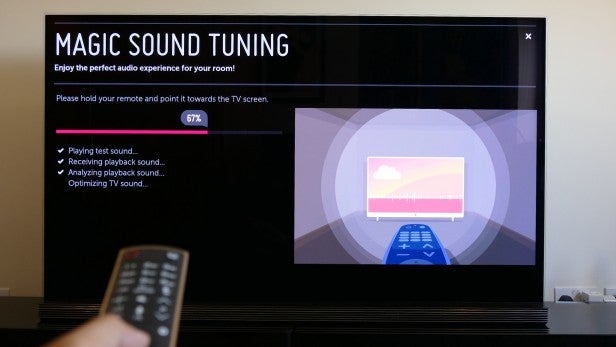
Atmos or no Atmos – what you get is a spacious soundstage that sounds much wider and taller than the TV’s physical dimensions. It has no problem with power and volume, and you can crank it without the sound hardening up. Tonal balance is good, with decent bass extension and a crisp treble. There’s enough weight and clarity here that I would happily let the TV handle big movie soundtracks without the assistance of proper speakers.
As for effects placement, it’s precise enough to impress, although I feel the Sony A1 OLED does a better job of tracking effects, both on and off screen. All in all, it’s an impressive integrated sound system, but don’t expect something truly cinematic.
There’s a very neat sound tuning option. The TV plays some test tones, designed to bounce around the room and end up in your remote control’s built-in microphone. The remote then feeds this information back to your TV, which works out your room’s acoustics and adjusts the sound accordingly. It’s a small difference but it works – in my test room, the TV dialed down the bass a little and the result was more natural than the default setting.
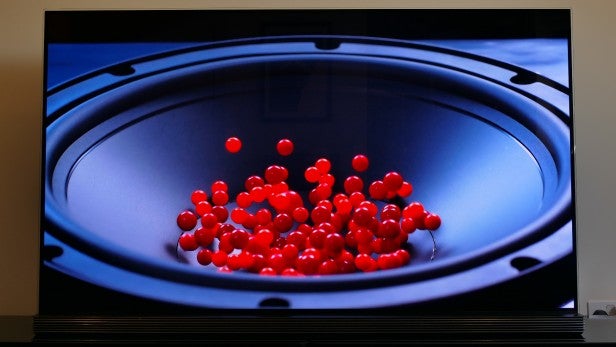
Should I buy the LG OLED65G7V?
LG’s product strategy this year means you can enjoy the same quality picture for less if you opt for the models with less fancy designs – such as the LG B7 and LG C7. They’re available for £2500 less at 65 inches. Then there’s the LG E7, £5000 at 65 inches, which is a compromise, keeping the gorgeous picture-on-glass design but swapping the folding sound base for a less powerful sound bar. If you do want to splash the cash, then the LG G7 won’t disappoint.
As for picture quality, LG’s OLEDs face strong competition from Sony and Panasonic. The Sony KD-65A1 (£5000 at 65 inches) does a better job with fine detail and motion, while the Panasonic TX-65EZ952B (£4799 at 65 inches) boasts class-leading colour accuracy. LG, meanwhile, counters with a more impactful HDR picture, lower input lag for gamers, as well as the best smart operating system of the lot.
Related: Best 4K TV
VERDICT
LG has already proved itself with OLED this year, and with the G7 it’s just showing off.
How we test televisions
We test every TV we review thoroughly over an extended period of time. We use industry standard tests to compare features properly. We’ll always tell you what we find. We never, ever, accept money to review a product.
Trusted Score
Score in detail
-
Value 7
-
Smart TV 9
-
Image Quality 9
-
Design 10
-
Sound Quality 9

